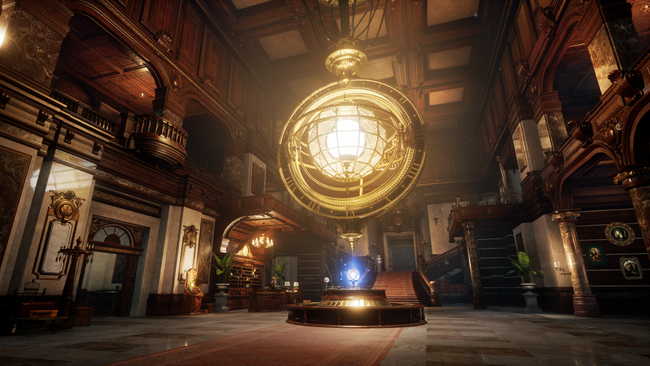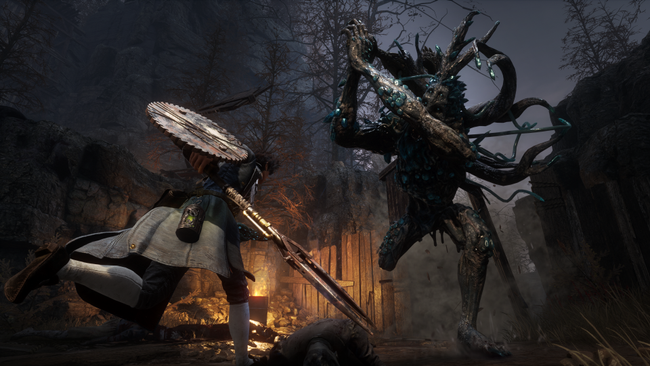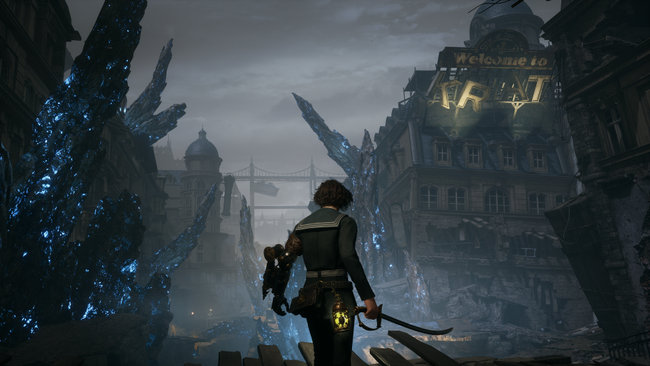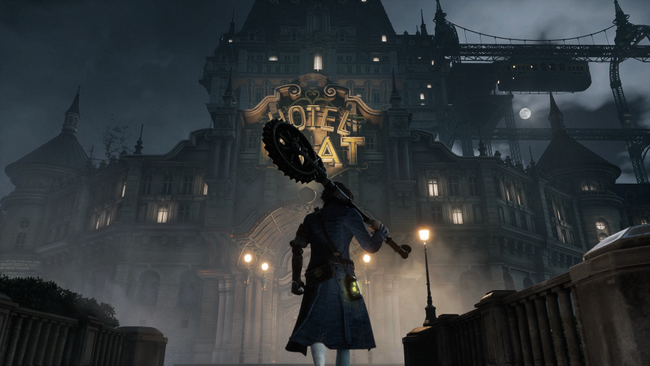Lies of P Review
It’s absolutely not fair of me to do so, but my initial reaction to news of any Souls-like game whatsoever is to think - initially - that “We have Souls games at home.” From my admittedly irrational perspective, I can’t help but question why I should give time or money to a "pretender" when I’m still in the process of engaging with the “true” Souls games for myself, no "-like" needed. Call me fortunate then, for this review assignment professionally obligated me to give Neowiz and Round8’s Lies of P a chance. I’m thankful for that, as it’s an enjoyable experience that carves out just enough of its own space in the monolith that is what From Software popularized.
Lies of P takes place in the city of Krat, a once-beautiful and bustling industrial-age metropolis, now teetering on the edge of ruin thanks to its signature technology: Automated puppets powered by Ergo, a mysterious fuel source. The puppets have gone mad, slaughtering their human masters and besieging the survivors in the grand Hotel Krat. You play a special puppet created by master artisan Geppetto. Awakened by the voice of Sophia, an ethereal maiden with blue hair, you set off to investigate the cause of the Puppet Frenzy and potentially save the city.
Frankly speaking, Lies of P doesn’t do much with its central narrative. Though much has been made about it being loosely (very loosely) based on the original Pinocchio story, other than the presence of familiar names and adapted plot points, the game may as well be entirely original. The main story contains few surprises. Once you've collected enough of the little bits of lore scattered throughout the game — as well as through small side quests and story sequences — to flesh out an image of Krat and the events surrounding the Puppet Frenzy, the beats of the plot become as clear as the thump of your clockwork heart on the main menu.
The atmosphere does work well enough to give the game a sense of character that the slightly stiff English localization can obscure. It's also easy to read an interesting "resource curse" metaphor in the rise of Krat from sleepy coastal village to industrial power, even before you bring in the parts of the that involve literal curses and alchemical magic. The Pinocchio gimmick of “lying” is limited to only a few points where you can choose to tell a lie or the truth, which is more about steering the game toward one of its three endings than a greater reflection on humanity. That Lies of P may as well be original isn’t a point against it, though: Framing Krat as a clockwork metropolis ravaged by frenzied puppets serves as a good structure on which to lay all manner of attractive visual concepts.

Aesthetically, Lies of P is a cousin to Bloodborne, with its vaguely European locale, but it leans heavily on the puppets and clockwork technology that set Krat apart from the likes of Yarnham, Boletaria, or Drangleic. The puppets, with their herky-jerky movements and clattering joints, are real standouts in the game’s bestiary of foes. The puppet bosses are also entertaining to watch and be killed by, with characters like the Scrapped Watchman, Parade Leader, and other corrupted marionettes combining the quaint cheer of the era with their decidedly inhuman movements and imposing combat styles.
In fact, I was slightly disappointed when events shifted and introduced elements of eldritch horror and boss designs that emphasized more traditional categories of gross-out fantasy. I liked beating on the puppets quite a bit more than the squishy monsters (the one exception being a fight against a big guy who is basically a vintage professional wrestler, complete with an entrance sequence). The locations are also inspired by the Belle Époque, full to the brim with grandiose pre-20th-century architecture. There’s something appealing about seeing this style of optimistic, World’s Fair-like scenery collapsed in fire and ruins, stalked by murderous mechanized beasts to fight.

One thing should be taken into account, however, when it comes to Lies of P’s aesthetic sensibility: 2022's Steelrising, which just so happens to be another Souls-like action RPG that focuses on period European style and uses clockwork automata. While the timing virtually ensures these two titles’ similarities were coincidental, it speaks to the gravity of Bloodborne that fully two separate games were created that blend its gameplay basics with similar twists on its motif. For its part, though, Lies of P is less specific about situating Krat in European history, while Steelrising explicitly casts your character amidst the French revolution (albeit with a lot more clockwork murderbots). I have not actually played Steelrising myself and thus can't speak to any more than a superficial comparison, but you can read Adam's review here.
Structurally, Lies of P hits many familiar Souls-like beats. You gather Ergo points from defeated enemies, and drop your Ergo when you die, taking a penalty to the dropped “Death Ergo” if you die again on the way to retrieving it. Naturally, the Ergo serves as your universal cash equivalent, spent in escalating amounts to level up your stats, upgrade your weapons, and buy consumable items and new gear. Each area features multilayered, looping level designs, with hazards, secrets, and shortcuts to unlock. Enigmatic NPCs often hand out largely unmarked side quests to add a bit of flavor or unlock new gear.

So far, so familiar. Much of what I’ve written about Lies of P’s structure could be written about many Souls-likes. That said, Lies of P comes across as altogether friendlier than some of its more notoriously cruel inspirations. You can use consumables to "insure" your Death Ergo, allowing you to keep your Ergo when respawning and forgoing a corpse run entirely. Checkpoints are relatively frequent, and even dying to a major boss drops your Ergo just outside the arena, so you can pick it up and use it to up your stats or improve your weapons before your next try. Pick up an item that you can’t fit in your quick-use belt? Don’t worry, it instantly teleports into your storage, which refreshes your uses on respawn. You can even sell consumables directly for a bit of extra Ergo, with some merchants expanding their stock when you find certain items in the world.
You can also unlock a whole host of beneficial perks by playing with your P-Organ (I giggle a bit every time I read that). Your Ergo-powered heart takes rare Quartz gems to unlock a bunch of useful effects, ranging from increasing the number of times you can use healing Pulse Cartridges, to allowing you to regain health on a perfectly timed guard. You can even lengthen your dodge, and unlock the ability to roll aside when knocked down, in case your foes try a wake-up attack. By the time I finished my first run, my P-Organ customizations had almost doubled my number of heals, and even caused them to recharge slowly when used up. I was also equipped with items that increased my resistance to status effects, physical damage, and even recharged my health gradually. Lies of P isn’t shy about letting you feel more and more powerful.

The game's real heart, though, lies in its unique “Weapon Assemble” system. Lies of P is home to dozens of weapons. From boring old sabers and greatswords to wild items like a moon-shaped rotating buzzsaw and the “Coil Mjolnir”, a sledgehammer with an electric tesla coil built into it, you have many ways to take the fight to the puppets and various horrors infesting Krat. Plus, most of the weapons split into a “Blade” and “Handle” component. The blade determines the weapon’s damage output and damage type, while the handle determines the weapon’s animations, as well as its stat scaling, boosting damage output based on your allocated stat points.
Blades and handles can be mixed and matched freely at any checkpoint or in the safe zone at the Hotel Krat. Blades can be upgraded to increase their damage output, while handles can be modified to change their stat scaling. On top of all that, weapons also have their “Fable Arts”. Each blade and handle comes with its own Fable Art, which is powered by a set of gauges that charge when you attack and hit well-timed blocks. The Arts themselves vary from powerful extended strike animations to temporary buffs and extra damage coatings (like setting your knife blade on fire). With all that in mind, you can really spend some time tweaking and putting together a favorite weapon.
Besides weapons, you can also equip a Legion Arm, a secondary device with a unique ability limited by fuel. Though the fuel gauge can keep them from being used all that often, the Legion Arm abilities unlock some unique combat options beyond your standard attacks. I liked the flamethrower arm as it allowed me to inflict a powerful damage-over-time effect to soften up bosses and quickly burn away weaker targets. Other Legion Arm abilities include a mine-laying arm, a grappling hook that pulls distant enemies or sends you in close for a powerful attack, and an arm that becomes a shield, temporarily enabling the Souls game classic stance of poking enemies while hiding behind protection.

Overall, Lies of P's weapon system allows for a great deal of customization and optimization for your build. For example, I found my workhorse weapon quite early in the game in the form of a Krat police puppet’s baton. Though the default baton has terribly short reach and unimpressive blunt damage, its quick, repetitive hacking animations are great for fighting in tight spaces and keeping lighter enemies off balance. So I mated that handle to a heavy greatsword blade, and later a bone-cutting saw.
The result was sublime, and I played for hours with that weapon, as the newly extended blade kept me out of my foes reach while its stat scaling meant my damage output ensured most menial foes were killed with minimum of fuss. Against bosses, though, with their often screen-wide swipes and gorilla-like attack patterns, my short reach proved a liability. Several more frustrating fights demanded wide sweeps and damage-multiplying specials, so I often swapped to a polearm-like grip attached to a burning steelcutter's blade, making the most of its doubled damage types.

In terms of combat, Lies of P combines the emphasis on dodging and aggression seen in the likes of Bloodborne with the parrying and counterattack-centered engagements of Sekiro, and this is most apparent in its many boss and mini-boss encounters. Bosses move quickly and strike hard, and blocking a hit will cause you to still lose health, which you can get back by striking an enemy shortly after taking damage. However, perfectly timing a block will result in a "Perfect Guard" that only drains your stamina, not your health. Perfect Guards also have a chance of destroying an enemy’s weapon, neutralizing their damage output.
There’s no feeling quite like having a foe break their weapon on yours, or receiving a massive, earthshaking impact and coming away with little more than shrug. This weapon-breaking can even happen to bosses (though it takes quite a bit longer), and the effect never stops being exhilirating. You can also stagger enemies with repeated attacks and successful Perfect Guards, setting them up to be stunned and then executed with a powerful Fatal Attack animation. Lies of P loves this parry and stagger system so much that I was quickly convinced to abandon my perfectionist attitude of trying to never, ever, get hit. Once I realized that the game favored me tanking hits and biting back while figuring out an enemy’s ideal guard timing, I met with much more success in battle.

Of course, your definition of “success” may vary. I spent dozens of tries on certain foes, and the last boss alone took me more than 43 attempts. But I have the feeling that someone with faster reactions or a lot of experience with Souls-likes or Sekiro will have little trouble adapting to and mastering Lies o P. For scrubs like yours truly, though, there is also a handicap in the form of a summonable NPC that can fight alongside you (to my knowledge there isn’t an online component to this summoning). The buddy doesn't last too long, but can be a welcome distraction that allows you to get free hits in. Lies of P may not be particularly novel when it comes to its core combat mechanics, but the experience is smooth, well-tuned, and facilitates that pulse-quickening "concentration zone" where after hours of frustration, every move seems to come together to help you take down a powerful foe. If I have a suggestion for a future patch addition, it'd be a more visible indicator of how close you are to staggering an enemy. At the moment, it just feels like a semi-random occurrence that happens when you whale away.
Despite its unique weapon system and generally friendlier structuring, Lies of P hews a little too closely to its inspirations to rise above feeling like something of an also-ran. But even also-rans can be polished, attractive, and exciting experiences in their own right. Every time I left a successful fight with my heart rate up and a sense of actual accomplishment brimming, it felt like I'd experienced a bit of Lies of P’s own truth.
Lies of P launches on September 19, 2023 for PS4, PS5, Xbox One, Xbox Series X|S, and PC.